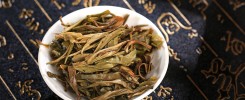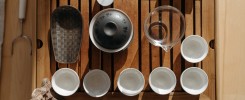When it comes to most teas—green, black, or oolong—the rule is simple: the fresher, the better. But Pu-erh tea breaks that rule entirely. This ancient tea from Yunnan, China, actually improves with time. So, how long does Pu-erh tea last? The real answer depends not just on the tea itself, but also on how it’s made, stored, and even the air around it.
As someone who has spent decades in tea cultivation and wholesale, I’ve learned that Pu-erh is less a beverage and more a living, evolving organism. Its lifespan isn’t measured in months, but in decades—or even centuries. Let’s explore what determines how long your Pu-erh can last, and how to tell when it’s at its best.
Table of Contents
1. Understanding Pu-erh’s “Living” Nature
Pu-erh tea is unique because it’s post-fermented. This means that after the leaves are processed, natural microorganisms continue to act on them, slowly transforming the flavor, aroma, and even the texture over time. Unlike most teas that go stale, Pu-erh continues to mature—developing deeper, smoother, and richer notes as years pass.
There are two main types of Pu-erh, and their aging behavior differs:
- Sheng (Raw) Pu-erh: This is the traditional form. When young, it tastes fresh and slightly bitter, but as it ages (5–30+ years), it evolves into something mellow, sweet, and woody. Properly stored Sheng Pu-erh can last for decades—some even age beautifully for 50 or more years.
- Shou (Ripe) Pu-erh: Created through an accelerated fermentation process, Shou Pu-erh is smoother and darker from the start. It doesn’t require long aging, but good-quality Shou can still improve over 10–20 years.
The reason Pu-erh can “last” so long lies in its microbial activity. These beneficial microbes protect the tea, preventing spoilage while enhancing complexity.
2. Shelf Life vs. Aging Potential
When people ask, “How long does Pu-erh tea last?” they often mean “When does it expire?” The surprising truth is—Pu-erh doesn’t really expire if stored correctly.
That said, there’s a big difference between “shelf life” and “aging potential.”
- Shelf life refers to how long the tea remains safe and pleasant to drink. Under good conditions, Pu-erh can last for several decades or even longer.
- Aging potential describes how long the tea continues to improve. After a certain point—often 30 to 50 years—the tea reaches its peak maturity. Beyond that, the transformation slows, and the flavor may gradually fade.
In other words, your Pu-erh might technically “last” forever, but its character won’t improve indefinitely. Like an old wine, there’s a moment when it reaches its prime—after which it simply holds steady.
3. Storage: The Secret Behind Longevity
The lifespan of Pu-erh depends almost entirely on how it’s stored. A well-made tea can easily be ruined by poor storage.
Here are the essentials for keeping Pu-erh alive and aging gracefully:
- Temperature: Keep it stable—ideally between 20–30°C (68–86°F). Extreme heat or cold can disrupt microbial balance.
- Humidity: Maintain around 60–70% relative humidity. Too dry, and the tea stops aging. Too humid, and it can develop mold.
- Airflow: Pu-erh needs gentle airflow to breathe. Avoid sealed containers; use breathable paper or clay jars.
- Odor Control: Keep it away from strong smells—tea absorbs odors easily.
- No Direct Sunlight: UV rays destroy delicate compounds and kill microbes that make Pu-erh age gracefully.
If you follow these principles, your Pu-erh can easily outlast you—and may even become a valuable heirloom.
4. How to Tell If Pu-erh Has Gone Bad
Although Pu-erh doesn’t “expire” in the usual sense, it can go bad under poor conditions. The key is to use your senses.
Signs your Pu-erh is still good:
- The leaves have a clean, earthy aroma (like forest floor or dried wood).
- The liquor is clear and bright when brewed.
- The taste is smooth, layered, and pleasant.
Warning signs of spoilage:
- A sour, rotten, or moldy smell.
- Visible white, green, or black fuzzy mold (not to be confused with harmless white tea frost).
- Cloudy or sticky liquor when brewed.
In short, if it smells like something you wouldn’t drink—it’s best not to.
5. Does Pu-erh Have an Ideal Drinking Age?
Many tea lovers ask: When is the best time to drink my Pu-erh? The answer depends on your taste preferences.
- Young Sheng Pu-erh (1–5 years): Fresh, grassy, sometimes bitter. Loved by those who enjoy vibrant, raw energy.
- Middle-aged Sheng (5–15 years): Balanced, sweet, and aromatic. This is when most teas reach harmony.
- Aged Sheng (15+ years): Deep, woody, and comforting, with lingering sweetness and complexity.
For Shou Pu-erh, 3–10 years is generally the sweet spot—long enough to refine the earthy flavor without losing its richness.
6. A Fresh Perspective: Pu-erh as a Living Legacy
Here’s something few people consider: Pu-erh tea doesn’t just “last”—it lives. Each cake carries microorganisms that adapt to its environment, subtly shaped by where and how you store it. That means your Pu-erh ages differently in New York than in Hong Kong or Paris.
In a sense, every tea collector creates their own version of the same tea—an expression of place, time, and care. This is why seasoned collectors say Pu-erh isn’t something you simply buy; it’s something you raise.
Final Thoughts
So, how long does Pu-erh tea last? With proper care, a lifetime or more. But the real beauty of Pu-erh lies not in how long it survives, but how it evolves.
Each year adds depth, smoothness, and wisdom to the leaves. Whether you’re storing it for decades or enjoying it today, Pu-erh teaches patience—the kind that rewards you with a cup full of history and life itself.
Treat your Pu-erh not as a product, but as a living companion. In the right hands, it doesn’t simply last—it thrives.

